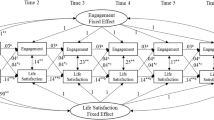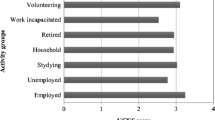Abstract
This article analyzes the Utrecht Work Engagement Scale (UWES; Schaufeli et al. in J Happiness Stud 3:71–92, 2002b) on a variety of levels. Study 1 critiques the method by which the original scale was developed, and analyzes a similar sample using both exploratory and, subsequently, confirmatory factor analyses. Study 2 uses three samples to explore the 17-item UWES-17, and the recent shorter version of the scale, the 9-item UWES-9. Factor structures and reliabilities of scores for both scale versions were examined for each sample. Although some cautions are warranted when using the UWES, this research leans toward supporting a multifactorial conceptualization of the construct. Preliminary construct validation of the use of the measures was also established via correlations with other pertinent constructs. Although research on the measure remains sparse, the UWES-9 holds promise as a parsimonious version of the UWES-17 that appears valid in use, appears to yield reliable scores in the samples herein, and also appears to capture the purported three-factor dimensionality of the engagement construct better than does the original UWES-17 version.
Similar content being viewed by others
Notes
Recognizing Chi-square’s susceptibility to sample size, additional goodness-of-fit indices are provided in Table 8.
References
Avey, J. B., Wernsing, T. S., & Luthans, F. (2008). Can positive employees help positive organizational change? Impact of psychological capital and emotions on relevant attitudes and behaviors. Journal of Applied Behavioral Science, 44, 48–70.
Boroff, K. E., & Lewin, D. (1997). Loyalty, voice, and intent to exit a union firm: A conceptual and empirical analysis. Industrial and Labor Relations Review, 51, 50–63.
Buja, A., & Eyuboglu, N. (1992). Remarks on parallel analysis. Multivariate Behavioral Research, 27, 509–540.
Byrne, B. M. (2001). Structural equation modeling with AMOS: Basic concepts, applications and programming. Mahwah, NJ: Lawrence Erlbaum.
Camman, C., Fichman, M., Jenkins, D., & Klesh, J. (1979). The Michigan Organizational Assessment Questionnaire. Unpublished Manuscript: University of Michigan.
Campbell, D. T., & Fiske, D. W. (1959). Convergent and discriminant validation by the multitrait-multimethod matrix. Psychological Bulletin, 56, 81–105.
Carmines, E. G., & McIver, J. P. (1981). Analyzing models with unobserved variables. In G. W. Bornstedt & E. F. Borgatta (Eds.), Social measurement: Current issues (pp. 65–115). Beverly Hills: Sage.
Christian, M. S., & Slaughter, J. E. (2007, August). Work engagement: A meta-analytic review and directions for research in an emerging area. Paper presented at the 67th annual meeting of the Academy of Management, Philadelphia, PA.
Connell, J. P., & Wellborn, J. G. (1991). Competence, autonomy, and relatedness: A motivational analysis of self-esteem processes. In M. R. Gunnar & L. A. Sroufe (Eds.), Self processes in development: Minnesota symposium on child psychology (Vol. 23, pp. 167–216). Hillsdale, NJ: Lawrence Erlbaum.
Costello, A. B., & Osborne, J. W. (2005). Best practices in exploratory factor analysis: Four recommendations for getting the most from your analysis. Practical Assessment, Research, and Evaluation, 10, 1–9.
Cronbach, L. J., & Meehl, P. E. (1955). Construct validity in psychological tests. Psychological Bulletin, 52, 281–302.
Csikszentmihalyi, M. (1975). Beyond boredom and anxiety: Experiencing flow in work and play. San Fransisco, CA: Jossey-Bass.
Csikszentmihalyi, M. (1990). Flow: The psychology of optimal experience. New York, NY: Harper & Row.
Eisenberger, R., Huntington, R., Hutchison, S., & Sowa, D. (1986). Perceived organizational support. Journal of Applied Psychology, 71, 500–507.
Fabrigar, L. R., Wegener, D. T., MacCallum, R. C., & Strahan, E. J. (1999). Evaluating the use of exploratory factor analysis in psychological research. Psychological Methods, 4, 272–299.
Gerbing, D. W., & Hamilton, J. G. (1996). Viability of exploratory factor analysis as a precursor to confirmatory factor analysis. Structural Equation Modeling, 3, 62–72.
Goffin, R. D., & Gellatly, I. R. (2001). A multi-rater assessment of organizational commitment: Are self-report measures biased? Journal of Organizational Behavior, 22, 437–451.
Hallberg, U. E., Johansson, G., & Schaufeli, W. B. (2007). Type A behavior and work situation: Associations with burnout and work engagement. Scandinavian Journal of Psychology, 48, 135–142.
Hayton, J. C., Allen, D. G., & Scarpello, V. (2004). Factor retention decisions in exploratory factor analysis: A tutorial on parallel analysis. Organizational Research Methods, 7, 191–205.
Horn, J. L. (1965). A rationale and test for a number of factors in factor analysis. Psychometrica, 30, 179–185.
Kinnunen, U., Feldt, T., & Mäkikangas, A. (2008). Testing the effort-reward imbalance model among Finnish managers: The role of perceived organizational support. Journal of Occupational Health Psychology, 13, 114–127.
Koestner, R., & Losier, G. F. (2002). Distinguishing three ways of being internally motivated: A closer look at introjection, identification, and intrinsic motivation. In E. L. Deci & R. M. Ryan (Eds.), Handbook of self-determination research (pp. 101–121). Rochester, NY: University of Rochester Press.
Luthans, F. (2002). The need for and meaning of positive organizational behavior. Journal of Organizational Behavior, 23, 695–706.
Luthans, F., Avolio, B. J., & Youseff, C. (2007). Psychological capital: Developing the human capital edge. Oxford: Oxford University Press.
Macey, W. H., & Schneider, B. (2008). The meaning of employee engagement. Industrial and Organizational Psychology: Perspectives on Science and Practice, 1, 3–30.
Maslach, C., & Leiter, M. P. (1997). The truth about burnout. San Francisco, CA: Jossey Bass.
Messick, S. (1995). Validity of psychological assessment: Validation of inferences from persons’ responses and performances as scientific inquiry into score meaning. American Psychologist, 50, 741–749.
Meyer, J. P., Allen, N. J., & Smith, C. A. (1993). Commitment to organizations and occupations: Extension and test of a three-component conceptualization. Journal of Applied Psychology, 78, 538–551.
Montgomery, A. J., Peeters, M. C. W., Schaufeli, W. B., & den Ouden, M. (2003). Work-home interference among newspaper managers: Its relationship with burnout and engagement. Anxiety, Stress, and Coping, 16, 195–211.
O’Connor, B. P. (2000). SPSS and SAS programs for determining the number of components using parallel analysis and Velicer’s MAP test. Behavior Research Methods, Instruments, & Computers, 32, 396–402.
Owen, S. V., & Fromen, R. D. (1988). Development of a college academic self-efficacy scale. Paper presented at the Annual Meeting of the National Council on Measurement in Education. New Orleans, LA.
Saks, A. M. (2006). Antecedents and consequences of employee engagement. Journal of Managerial Psychology, 21, 600–619.
Salanova, M., Schaufeli, W. B., Llorens, S., Peiró, J. M., & Grau, R. (2001). Desde el ‘burnout’ al ‘engagement’: ¿una nueva perspectiva? [From “burnout” to “engagement”: A new perspective?] Revista de Psicología del Trabajo y de las Organizaciones, 16, 117–134.
Schaufeli, W. B., & Bakker, A. B. (2004). Job demands, job resources, and their relationship with burnout and engagement: A multi-sample study. Journal of Organizational Behavior, 25, 293–315.
Schaufeli, W. B., & Salanova, M. (2007). Efficacy or inefficacy, that’s the question: Burnout and engagement, and their relationships with efficacy beliefs. Anxiety, Stress, & Coping, 20, 177–196.
Schaufeli, W. B., Bakker, A. B., & Salanova, M. (2006). The measurement of work engagement with a short questionnaire: A cross-national study. Educational and Psychological Measurement, 66, 701–716.
Schaufeli, W. B., Martínez, I. M., Marques-Pinto, M. A., Salanova, M., & Bakker, A. B. (2002a). Burnout and engagement in university students: A cross-national study. Journal of Cross-Cultural Psychology, 33, 464–481.
Schaufeli, W. B., Salanova, M., Gonzalez-Romá, V., & Bakker, A. B. (2002b). The measurement of engagement and burnout: A confirmative analytic approach. Journal of Happiness Studies, 3, 71–92.
Schaufeli, W. B., Taris, T. W., Le Blanc, P. M., Peeters, M., Bakker, A. B., & De Jonge, J. (2001). Maakt arbeid gezond? Op zoek naar de bevolgen werknemer [Does work make people healthy? In search of the engaged worker]. De Psycholoog, 36, 422–428.
Seligman, M. E. P., & Csikszentmihalyi, M. (2000). Positive psychology: An introduction. American Psychologist, 55, 5–14.
Seppälä, P., Mauno, S., Feldt, T., Hakanen, J., Kinnunen, U., Tolvanen, A., et al. (2009). The construct validity of the Utrecht Work Engagement Scale: Multisample and longitudinal evidence. Journal of Happiness Studies, 10, 459–481.
Shirom, A. (2003). Feeling vigorous at work? The construct of vigor and the study of positive affect in organizations. In D. Ganster & P. L. Perrewe (Eds.), Research in organizational stress and well-being (Vol. 3, pp. 135–165). Greenwich, CT: JAI Press.
Silverstein, A. B. (1987). Note on the parallel analysis criterion for determining the number of common factors or principal components. Psychological Reports, 61, 351–354.
Smith, G. T., McCarthy, D. M., & Anderson, K. G. (2000). On the sins of short-form development. Psychological Assessment, 12, 102–111.
Snape, E., & Redman, T. (2003). An evaluation of a three-component model of occupational commitment: Dimensionality and consequences among United Kingdom human resource management specialists. Journal of Applied Psychology, 88, 152–159.
Sonnentag, S. (2003). Recovery, work engagement, and proactive behavior: A new look at the interface between non-work and work. Journal of Applied Psychology, 88, 518–528.
Spector, P. (2006). Method variance in organizational research: Truth or urban legend? Organizational Research Methods, 9, 221–232.
Steers, R. M., & Braunstein, D. N. (1976). A behaviorally based measure of manifest needs in work settings. Journal of Vocational Behavior, 9, 251–266.
Vallerand, R. J., Pelletier, L. G., Blais, M. R., Brière, N. M., Senecal, C. B., & Vallieres, E. F. (1992). The academic motivation scale: A measure of intrinsic, extrinsic, and amotivation in education. Educational and Psychological Measurement, 52, 159–172.
Van Prooijen, J. W., & Van Der Kloot, W. A. (2001). Confirmatory analysis of exploratively obtained factor structures. Educational and Psychological Measurement, 61, 777–792.
Watson, D., Clark, L. A., & Tellegen, A. (1988). Development and validation of brief measures of positive and negative affect: The PANAS scales. Journal of Personality and Social Psychology, 54, 1063–1070.
Wheaton, B., Muthén, B., Alwin, D. F., & Summers, G. F. (1977). Assessing reliability and stability in panel models. In D. R. Heise (Ed.), Sociological methodology (pp. 84–136). San Francisco: Jossey Bass.
Worthington, R. L., & Whittaker, T. A. (2006). Scale development research: A content analysis and recommendation for best practices. Counseling Psychologist, 34, 806–838.
Wothke, W. (1993). Nonpositive definite matrices in structural equation modeling. In K. A. Bollen & J. S. Long (Eds.), Testing structural equation models (pp. 256–293). Newbury Park, CA: Sage.
Zwick, W. R., & Velicer, W. F. (1986). Comparison of five rules for determining the number of components to retain. Psychological Bulletin, 99, 432–442.
Acknowledgments
Grant information to be given upon publication of final manuscript: It is omitted here for purposes of blinding the manuscript to author-identifying information, as per Journal of Happiness Studies requirements.
Author information
Authors and Affiliations
Corresponding author
Rights and permissions
About this article
Cite this article
Mills, M.J., Culbertson, S.S. & Fullagar, C.J. Conceptualizing and Measuring Engagement: An Analysis of the Utrecht Work Engagement Scale. J Happiness Stud 13, 519–545 (2012). https://doi.org/10.1007/s10902-011-9277-3
Published:
Issue Date:
DOI: https://doi.org/10.1007/s10902-011-9277-3




